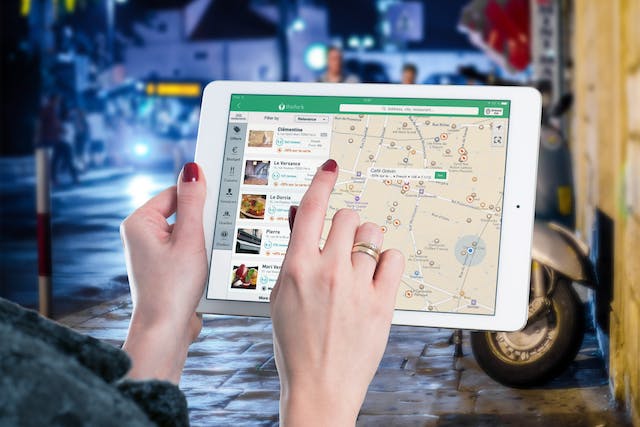Between the vast datasets, machine learning algorithms, the advent of edge computing, and the intersection of AI with other technologies like blockchain and 5G, the world is now seeing a rise in intelligent machines and software. While many are quick to associate its everyday use with the distant future, the reality is these technologies are readily available now in certain applications.
For example, as a result of AI, mapping tools allow users to get a quick view of their neighborhood and truly immerse themselves in a location. Consider a few ways you might already be experiencing AI in action.

Predictive Analysis
Location intelligence powered by AI can provide predictive insights. This means that maps can not only show the current state of an area but also offer forecasts or predictions based on historical data and machine learning algorithms, adding a forward-looking dimension to the map experience. As one example, you might try using time slider features, to observe how the surroundings of the British Museum in London vary at different times of the day and check the anticipated weather conditions. This tool enables you to identify peak crowded periods, empowering you with comprehensive information to make informed decisions about when and where to visit.
Additionally, if you need a meal, you can seamlessly navigate down to street level using the tool, allowing you to explore nearby restaurants. You can even take a virtual peek inside these establishments to gauge the ambiance before making a reservation.
Aerial View
A second area AI is making maps more immersive is in new aerial view APIs, which allows developers to effortlessly incorporate a 3D birds-eye video of a specific point of interest into their apps, providing users with enhanced visual information about a location. One example of when aerial view may come in handy is for those looking for a new place to live. Mapping tools, in turn, can use the Aerial View API to assist renters in visualizing a property and its surroundings, enabling them to explore a neighborhood virtually and make a better decision about their living arrangements.
Augmented Reality Integration
AI and augmented reality (AR) integration allow digital information to overlay seamlessly onto the physical world, creating an even more immersive user experience. In practical terms, real-time data and contextual details about the surroundings, ranging from business information to points of interest and historical context, are readily available to users of AI mapping technology. In practical application, AI’s impact extends to photorealistic 3D tiles, made accessible through advanced tools like the Map Tiles API. This tool unlocks the potential of high-resolution, 3D imagery, empowering developers to effortlessly incorporate these visuals into their applications. This approach eliminates the need to construct a 3D map from scratch, streamlining the development process.
For instance, a tourism company can leverage this technology to craft a captivating 3D map of a national park, complete with photorealistic imagery showcasing mountains, water bodies, and lush greenery. This immersive representation serves as a compelling enticement for travelers considering a visit. Additionally, businesses can curate interactive map tours featuring architectural landmarks, strategically overlaying markers to share historical information.
Custom Recommendations
AI algorithms analyze user behavior, preferences, and historical data to predict and suggest personalized recommendations, such as nearby restaurants, attractions, or events, creating a more immersive and customized mapping experience.
Dynamic Traffic Management
AI is instrumental in dynamic traffic management, predicting traffic congestion, accidents, or road closures. Therefore, you can use this information to reroute yourself in real-time, ensuring a smoother navigation experience and minimizing delays.
Personalized Experiences
AI can analyze user preferences, behavior, and historical data to personalize map experiences. This includes suggesting relevant points of interest, routes, and information based on individual preferences, making each user’s map interaction more tailored and immersive.
Natural Language Processing (NLP)
AI-driven NLP enables users to interact with mapping systems using natural language, making the experience more intuitive. Users can ask questions, seek recommendations, or request directions using conversational language, enhancing the overall accessibility and user-friendliness of mapping applications.
Transforming The Experience
Integrating location intelligence in AI transforms maps into immersive and dynamic tools beyond static representations. Therefore, rather than fearing away from the technology many believe will take their jobs, you might consider making the most of its readily available applications.


